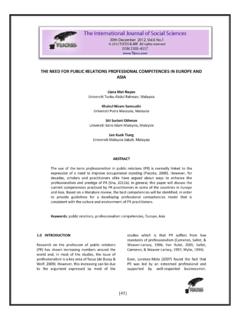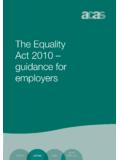Transcription of A REVIEW OF SOCIOLOGICAL FACTORS ASSOCIATED WITH …
1 A REVIEW OF SOCIOLOGICAL FACTORS ASSOCIATED with diabetes mellitus . BY. *. Azuamah, , Department of Optometry, Madonna University, Elele, Rivers State, Nigeria Imaseun, and Onoseta, , Department of Nursing Science, Madonna University, Elele, Rivers State, Nigeria Onuoha, , Department of Medical Laboratory Science, Madonna University, Elele, Rivers State, Nigeria ABSTRACT. diabetes mellitus is not a single disease entity but rather a group of metabolic disorders sharing the common underlying feature of hyperglycemia. This REVIEW paper takes a look at the major SOCIOLOGICAL FACTORS ASSOCIATED with increased blood glucose levels and its control. Among these FACTORS include the socioeconomic status of individuals, their ethnicity, sex and religion. Other SOCIOLOGICAL FACTORS mentioned in this paper are people's lifestyle, obesity, consumption of alcohol, genetics, marital status, health education and age.
2 Genetics is known to be a major factor in diabetes mellitus as many people with diabetes mellitus tend to have family members especially parents and siblings with the disorder. Socioeconomic status also plays a major role as people in the lower socioeconomic status tend to have diabetes more than those in the higher socioeconomic status. Age is also known to be a factor in Type 2. diabetes as most people with this type of diabetes tend to show symptoms from the age of 40 and above. Other SOCIOLOGICAL FACTORS mentioned are discussed in detail 1. INTRODUCTION stroke, and blindness . Some of the ocular effects of diabetes include diabetic retinopathy, diabetic diabetes mellitus is a group of metabolic macular edema, diabetic papillopathy and diseases in which a person has high blood sugar, diabetic cataract. Glaucoma is also ASSOCIATED 2. either because the pancreas does not produce with diabetes mellitus .
3 Enough insulin, or because cells do not respond Blood glucose values are normally to the insulin that is produced. This high blood maintained in a very narrow range, usually 70 to 3. sugar produces the classical symptoms of 120mg/dl . The diagnosis of diabetes is polyuria (frequent urination), polydipsia established by noting elevation of blood glucose 4. (increased thirst) and polyphagia (increased by any of the three criteria : hunger). diabetes mellitus is a chronic disease 1. A random glucose > 200mg/dl, with which causes serious health complications classical signs and symptoms. including renal (kidney) failure, heart disease, 2. A fasting glucose > 126mg/dl on 131. more than one occasion middle age when many individuals are at highest 7. 3. An abnormal oral glucose tolerance risk for developing diabetes . Access to adequate test (OGTT), in which the glucose is > 200mg/dl 2 health care plays an even stronger role in hours after a standard carbohydrate load.
4 Controlling diabetes , preventing the The vast majority of cases of diabetes fall development of complications, and avoiding into one of two broad classes: Type 1 diabetes diabetes -related mortality. Low socioeconomic characterized by an absolute deficiency of insulin status may also influence the development of caused by pancreatic -cell destruction. It diabetes as a result of inadequate maternal 6. accounts for approximately 10% of all cases. Type nutrition during and even prior to pregnancy . 2 diabetes is caused by a combination of peripheral resistance to insulin action and an Ethnicity inadequate secretory response by the pancreatic -cells. Approximately 80% to 90% of patients Diagnosed diabetes is present in about 7% of have type 2 diabetes . all adults 45 years and older; however, the rates The major SOCIOLOGICAL FACTORS affecting vary substantially by ethnicity. Data from the diabetes mellitus include; Socioeconomic status, Third National Health and Nutrition Examination Health Education, and socio-cultural statuses.
5 Survey and the Hispanic Health and Nutrition Others include; Religion, Ethnicity, Family, Age, Examination Survey indicate that among adults Physical attributes, Education, Locality or aged 40 to 74 years, the prevalence of diagnosed location, Life partner and Children. diabetes is about 7% for non-Hispanic Whites, 12% for African Americans, and 14% for both SOME SOCIOLOGICAL FACTORS Mexican Americans and Puerto ,12. ASSOCIATED with diabetes mellitus Among the various Asian American and Pacific Islander groups, the rates of diabetes vary Socioeconomic Status substantially but can be as high as 15% to 20%.11. The highest rates are experienced by Native Type II diabetes was found to American tribes in the Southwest, with an disproportionately affect socio-economic status estimated prevalence of more than 37%.13. (SES). The main factor contributing to Type II Indeed, the highest prevalence of diabetes in the mellitus in lower status are nutrition, education world (50%) is experienced by the Pima Indians 8.
6 And physical inactivity. The socially and of Arizona . economically disadvantaged are also at elevated 5. risk for diabetes . In addition, whereas the diabetes is often undiagnosed in the adult majority of individuals with type 2 diabetes are population, because type 2 diabetes is generally employed, a sizeable proportion are asymptomatic in its early stages and without unemployed. Among adults aged 45 to 64 years, regular screening goes undetected. The for example, 49% of diabetics are unemployed, prevalence of undiagnosed diabetes has been 6. compared with only 28% of non-diabetics . estimated to be about 6% for non-Hispanic Whites, 7% for African Americans, 10% for Socioeconomic inequalities in health have Mexican Americans, 12% for Puerto Ricans, and been attributed to a variety of mechanisms that as high as 15% for Native Americans. These large may act as intermediate risk FACTORS for diabetes .
7 Percentages of undiagnosed diabetes show not These include poor nutrition, overweight, only that the burden of diabetes is much greater increased rates of poor health behaviors such as than is indicated by the statistics for diagnosed smoking and alcohol consumption, stress, and disease but also that the unrecognized burden is limited access to health care, particularly in 132. greatest among the non-White culturally diverse pass them on to younger generations can make it 9. groups . difficult for a mother or grandmother to 10. successfully make lifestyle changes . Women It is significant that non-White populations also suffer from gestational diabetes , or glucose not only experience higher prevalence of type 2 intolerance that begins during pregnancy. diabetes but also suffer from more frequent Gestational diabetes complicates about 5% of all complications and greater disease severity.
8 Pregnancies, but the rate of occurrence can Studies of older adults with diabetes have shown range up to 14% depending on the population that both Mexican Americans and African subgroup. When left untreated, gestational Americans experience a greater burden from diabetes harms both the mother and infant, diabetes than do older non-Hispanic Whites. This often resulting in chronic hypertension as well as is particularly evident with regard to mortality perinatal morbidity and mortality. Gestational resulting from diabetes . Overall age-adjusted diabetes is most likely to occur among women death rates from diabetes are about 10% for older than 25 years, those who are obese, those non-Hispanic Whites, 20% for Hispanic with a family history of diabetes , and those who Americans, and 30% for African Americans and are members of the ethnic groups at higher risk Native Americans. These differences are even for diabetes in general African Americans, more apparent when one compares the rates of Native Americans, Mexican Americans, Asian diabetes across the older ages.
9 Among non- Americans, and Pacific Islanders. Although most Hispanic Whites, the prevalence of diabetes is women with gestational diabetes regain their about 10% both for adults aged 65 to 74 and for normal health in the months following delivery, those 75 years and older. In contrast, the rate of they remain at elevated risk for developing type diabetes among African Americans drops from 2 diabetes later in adulthood. Only about 5% of 20% among adults aged 65 to 74 years to only women with gestational diabetes develop type 2. 14% among those 75 and older. Similarly, the diabetes within 6 months of delivery; however, rate of diabetes among older Mexican Americans 40% to 50% develop diabetes after 15 years, 10. drops from 25% among adults aged 65 to 74 particularly among non-White women . Many of years to 18% among those 75 to 84 years to only the risk FACTORS for diabetes have a greater 12% among those 85 years or older.
10 These impact among women than among men. decreasing prevalence rates reflect increased 9. mortality among Africans . Sex Religion It is thought that much of this difference Religious activity has been defined as the between the sexes results from varying rates of degree of participation in and adherence to the obesity, physical activity, and hormone action teaching and the organized activity of a particular among women. In addition, certain sociocultural religion. Religious belief on the other hand, is the FACTORS , such as the role that women play in the fundamental belief system that could influence family, may affect women's vulnerability to our ideas, values in life and ways of living. Many diabetes . Women are often the keepers of patients recognize the importance of religion in culture, the family members who pass on cultural their health care management. Specific religious practices, such as what foods are served for observance Ramadan and Specific food holiday celebrations or what activities family avoidance may have potential adverse effects on members are encouraged to engage in.







